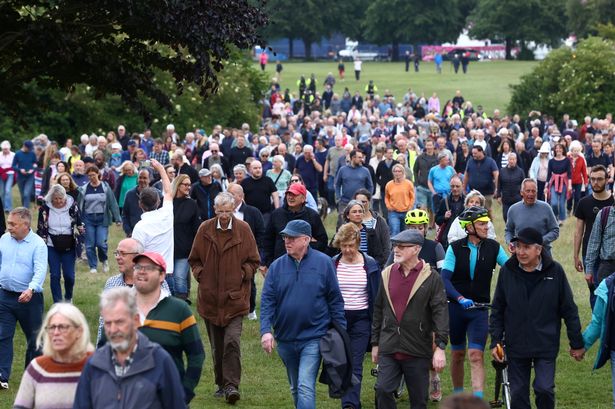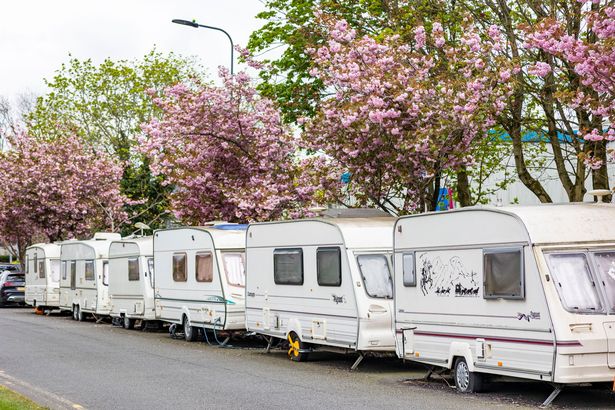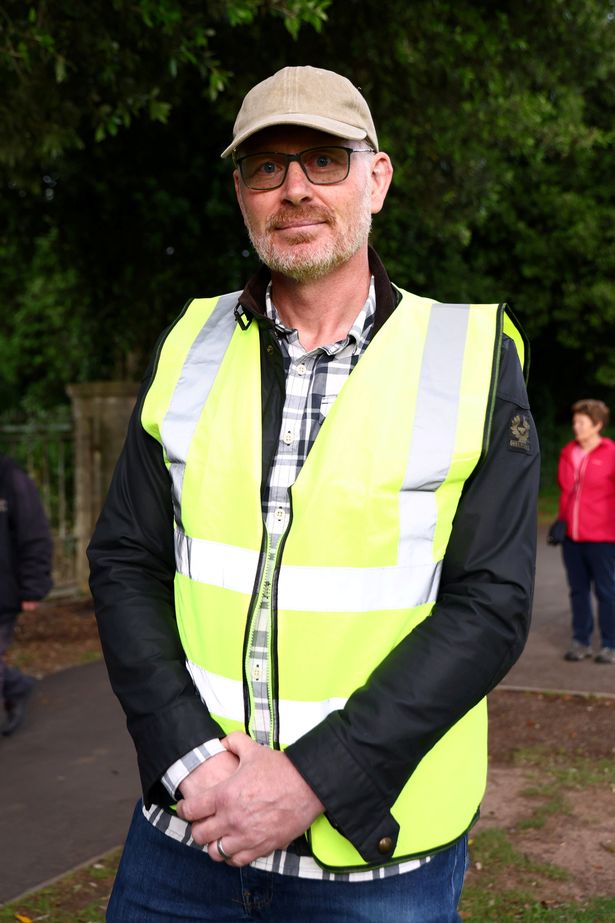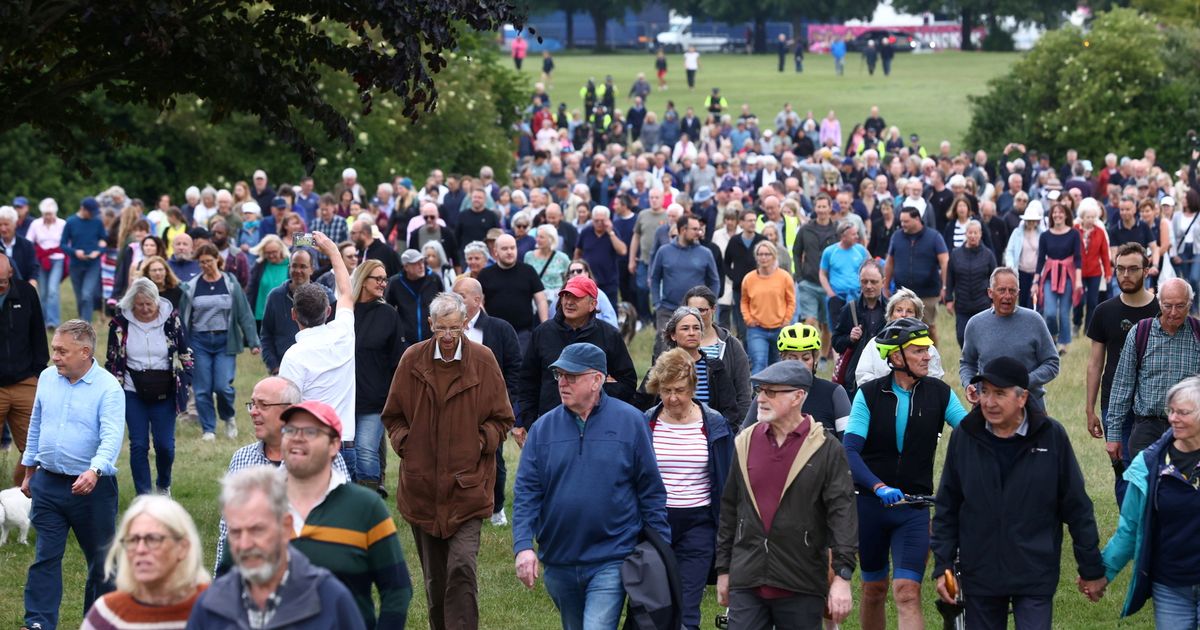The situation is getting heated The ‘Show of Support’ walk on the Downs(Image: Tom Wren / SWNS)
The ‘Show of Support’ walk on the Downs(Image: Tom Wren / SWNS)
They came from all corners of the Downs, across a classic Bristol scene which encapsulates what this unique open space is all about.
A football match was taking place on one of the Downs League pitches. Parents and children tried to fly kites in the sunshine. A workout class with some fearsome looking kettlebells was in full swing.
Couples and small groups of students tested the grass to see if the morning rain had dried yet, and excited partygoers got off buses to queue up for that evening’s Ladyboys of Bangkok show, in a huge garish pink temporary tented arena opposite the water tower.
But under the trees between Stoke Road and the water tower, an argument was raging. Two men of roughly the same age were gesticulating, raising their voices, pointing and becoming heated and animated.
Other people gathered, including local and national media, and the two men became conscious they had an audience. The temperature cooled a bit each time one acknowledged a point of agreement, or when one appreciated the other’s position, and there was never any question that the police officers, who were quietly in the background, would have to step in.
But the argument was about the big issue of the day, the week, the month and the year for many people in this part of Bristol – what should be done about the vans and caravans?
It’s a question that brought hundreds of people to this spot on a sunny Thursday evening in June, from all across the residential streets that ring the Downs. Answering a call from a newly-formed residents’ campaign group called Protect the Downs, this was a ‘Show of Support’ for the Downs and a direct challenge to Bristol City Council.
Organisers donned fluorescent bibs, local councillors were mingling. The chairman of Protect the Downs, Tony Nelson, made a speech appealing to the gathered crowd to have well-mannered conversations with the people who are currently living in vans, caravans and tents in the northern parts of the Downs, and said their focus was Bristol City Council.

They walked off heading away from the lines of caravans, approached the Sea Walls, then curved round to walk along the northern edge of the green space, never really approaching the caravans.
But things are getting heated. Earlier this year, there was standing room only at a nearby church as residents seized the chance to grill the man in charge of housing in Bristol, Cllr Barry Parsons (Green, Easton) about the gradual build up over the past few years of caravan and van dwellers on the Downs. The campaign group formed from that meeting, the protest march was its first actual public event or demonstration.
Protect the Downs has a Facebook group, where local residents share their fury and frustration at the council’s lack of action. Sometimes, as the van-dwellers are increasingly claiming, that boils over into threats and discriminatory language.
For this has been an argument played out just as much online as it is on the ground – in fact, probably more so. Youtubers have come to make shock and awe videos, national media describe the place as a ‘shanty town’. It’s become another front in some kind of culture war.
For the residents of Stoke Bishop, Westbury Park, Sneyd Park and Clifton, the inaction by Bristol City Council is infuriating but also baffling. One of the first people to speak up at the public meeting in March said the issue was about vehicles being parked for too long in a parking space. He said he couldn’t understand why the head of housing had come, when it was about creating and enforcing parking restrictions.
READ MORE: Fury as Bristol’s high rents used to promote luxury developmentREAD MORE: Bristol’s caravan city on the Downs ‘not sustainable’ admits council chief
The truth few will say, of course, is that Bristol City Council could begin to quickly move on all the lived-in caravans and vans within days if they chose to, with bylaws, new waiting limits and then parking tickets, notices a towaway scheme, but the reason they don’t is because where, exactly, would 130-odd people currently living in vans go to next?
One van-dweller, who declined to be named, watched as the hundreds of people began their walk. “There are people living in vans all over the city, because this city has a huge housing crisis,” he said. “Until now it hasn’t really affected the people living around here, this is probably the most affluent part of Bristol. I don’t think the people here fully comprehend just how impossible it is for someone to be able to rent or buy a place in Bristol now.
“So now the housing crisis has finally reached their doorsteps and suddenly they aren’t happy. The fact is actually the Downs is one of the better places for people living in vans to go – it’s huge, it’s not blocking the way, and if we had some facilities, the impact on the area would be a lot less,” he added.
Nobody really knows how many ‘lived-in vehicles’ there are in Bristol, and the Downs is not the only place with large numbers in one spot. Earlier this year, the roads near the Patchway Trading Estate were filled with caravans, for example.
 Vans parked up near Patchway Trading Estate in Bristol – pictured in April 2025(Image: Tom Wren / SWNS)
Vans parked up near Patchway Trading Estate in Bristol – pictured in April 2025(Image: Tom Wren / SWNS)
The council’s most recent estimate was 640-680, which means that, for every one van or caravan-dweller on the Downs, there’s another five or six out in the rest of the city.
But van-dwellers themselves reckon there are hundreds more who are living far more stealthily for the council to spot. Most residential streets in Bristol, in areas without Residents Parking Schemes like Bedminster, Knowle, Easton, St Werburghs, Fishponds, may well have one or several lived in vans at any one time – just feet from people’s front doors, rather than the hundreds of yards they are on the Downs.
Those inside move around regularly to avoid annoying people living in the houses, and hold down jobs, education and lives while living on the streets. For others there’s always strength in numbers – hence why many prefer to gather in small or large groups, and head to empty industrial estate unit car parks, or sites that have been earmarked for developments that are still months or years away.
The issue for Tony Nelson is the impact the lines and lines of dilapidated caravans is having on the Downs, and the people who regularly use the space for all kinds of recreation. That anti-social impact was what prompted the council to crack down on the last major caravan group on a public road – around Greenbank Cemetery in Easton. The same thing should be applied to the Downs, and the council should act quickly, he said.
 Tony Nelson, the chairman of Protect the Downs(Image: Tom Wren / SWNS)
Tony Nelson, the chairman of Protect the Downs(Image: Tom Wren / SWNS)
“Some people believe this is common land and they can do what they like,” he said. “This is not common land, this land was gifted to the people of Bristol. It belongs to the people of Bristol, and you are hear to represent the people of Bristol and reclaim the Downs as your land.
“The council manage this on your behalf, that’s all they do. So our views matter, our presence matters,” he added.
Mr Nelson said the council needed to do better, both for the Downs and the local residents, but also for the van dwellers themselves. “We got together because the council weren’t taking action, with an attitude of anything goes. They are doing nothing, they are not communicating anything.
READ MORE: New Bristol ‘build-to-rent’ apartments almost £2,000 a monthREAD MORE: Spike in numbers of entire homes ‘lost to Airbnb’ in Bristol
“We’ve had a message saying ‘we’re writing a new policy’, but we need action. They don’t even know how many vans are here, they’ve got an estimate for the whole of Bristol, but on the Downs how many are there that are occupied. The answer is not all of them.
“A lot of them are used for drug-dealing, there’s slum-letting going on, and there’s all sorts of horrible stories about people being pushed into those vans, so we just don’t know what’s going on, and neither do the council, which is the point,” he added.
“We’re trying to get the council to go and find the truly homeless, help them, and all these other people on the bandwagon, we need to move them on, because they’ve come from all over the UK because Bristol is a soft touch,” he added.
 Bristol City Councillor Barry Parsons (Green, Easton)(Image: Paul Gillis)
Bristol City Councillor Barry Parsons (Green, Easton)(Image: Paul Gillis)
The city council’s position, explained by Cllr Parsons at the public meeting in March, at City Hall and in several statements on the issue this year so far, is that the issue of van-dwellers is a city-wide one, and the city council has to sort it across the city, not just on the Downs.
“The number of people living in vehicles and caravans in Bristol has grown significantly in recent years and we recognise the challenges this growth in the size and number of encampments raises for our city,” said Cllr Parsons. “We have to acknowledge it’s a complex situation, and one I and others have spoken about on many occasions in the past twelve months.
“Fundamentally we want to make sure that all communities, including those living in vehicles or caravans, and those in homes in neighbourhoods, have a meaningful and fair chance to live healthy and safe lives. This means we need to take action on a number of fronts to make sure we are balancing the needs of everyone, whilst prioritising our efforts where the need is greatest,” he added.
The previous Labour administration brought in a policy and process which saw van dwelling groups ranked by council officers on the impact their presence was having on local residents or businesses. The council would only act, as it did in Greenbank, if it was deemed to be a ‘high impact’. So far at least, the council has assessed the 130-odd caravans and vans on the Downs as ‘medium’.
The long-term answer, for Cllr Parsons and Bristol City Council, is to create more ‘meanwhile sites’ – official places where van dwellers can park up, which have proper services like sanitation and waste collection. The council wants to create spaces for 250 vans, but they are likely to be on places like the Northern Slopes between Knowle West and Bedminster, Hengrove Park, in South Bristol, or other areas away from the city centre.
There is, of course, no guarantee that someone living in a van on the Downs or on a road in Bedminster, with a job nearby, will willingly move to the outer parts of the city, if they don’t have to.
The local councillor for the north side of the Downs is Cllr John Goulandris (Con, Stoke Bishop). He supports the council’s aim to create more ‘meanwhile sites’, but not if they are on the Downs.
“No, not on the Downs, you’re not allowed to do that with the Downs Act in any case. That wouldn’t be permitted,” he said. “I am in favour of finding sites, but we’re only obliged to find sites for those who have links with Bristol, and that’s the point. A lot of the van dwellers do not have links with Bristol,” he added.
